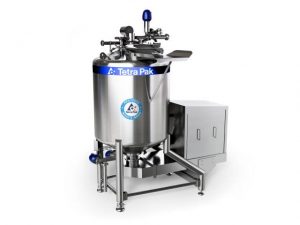The Consumer Trends Presenting New Processing Challenges and the Role of Mixing and Blending

By Anders Yngwe Soderstjerna, Centre of Expertise Director, Tetra Pak
Mixing and blending ingredients into a liquid medium is a common process, however with increased pressures on manufacturers to create more diverse products – all with the same smooth and consistent homogenous natural quality – it is a process that remains as important as ever. Over the last five years there has been an increased focus on processing efficiency gains, as well as balancing the refinement of product quality and consistency. The challenge for manufacturers is to combine these improvements with a large-scale expansion of their product portfolio to meet changing consumer demands. Consumers are looking for products that cater to their nutritional needs, as well as offer an exciting experience.
There are three key trends driving consumer demand:
- a preference for food and beverage products that help consumers live a healthy lifestyle;
- a desire for products offering ‘on-the-go’ convenience,
- and a focus on products with a ‘natural, homemade’ quality.
The Importance of Mixing and Blending
Mixing and blending is critical because it is the processing phase in which product ‘value add’ is created. If the correct approach isn’t employed at the start of processing, the batch will either be unusable or inconsistent, therefore compromising product value significantly. By applying the right expertise from the start, manufacturers can achieve unique product characteristics that set themselves apart from the competition.
Manufacturers must have complete control over every aspect of production from beginning to end. This ranges from having the right initial mixing solution for the product, to having detailed oversight of the many different factors that affect mixing efficiency, and all important end-product quality factors such as texture and taste. Control is essential for ensuring food safety, Tetra Pak’s number one priority. The safety of a product is primarily contingent on the balance of ingredients and the level of heat applied during processing to ensure that the product is adequately sterilized. The number of ingredients variables is increasing. They are now offered in powders, pastes and multiple other forms. It is therefore important that processors can guarantee product consistency and safety, regardless of new ingredient combinations.
Powders, which have a longer shelf life, are a particular focus point for processors. They are smaller and lighter, making them more convenient to transport. However, some such as aspartame, powdered milk, and tea powders are prone to foaming and therefore require a special mixing and blending approach.
The Integral Role of Processing in Satisfying Consumer Demand
 Consumer trends are driving interest in specific products. They’re looking for products that contain functional ingredients such as added vitamins and protein for general health and physical recovery from exercise. Ambient products, such as longer shelf life yoghurt and beverages are supporting on-the-go consumption, and more ‘natural’ products with fruit and nut particles are meeting the demand for a more natural, homemade quality.
Consumer trends are driving interest in specific products. They’re looking for products that contain functional ingredients such as added vitamins and protein for general health and physical recovery from exercise. Ambient products, such as longer shelf life yoghurt and beverages are supporting on-the-go consumption, and more ‘natural’ products with fruit and nut particles are meeting the demand for a more natural, homemade quality.
These demands present new processing challenges for manufacturers. At Tetra Pak, we offer our 60-year expertise in providing automated food and beverage solutions to customers combined with a deep understanding of food technology and the challenges manufacturers are facing. To ensure we can consistently offer this service globally, we have established over ten Product Development Centres (PDCs). These centres provide customers with access to experts who can help them test recipes and machinery simultaneously, finding an optimal solution and fast tracking the process of turning ideas into new products and categories that will capture the attention of modern consumers.
In conclusion, to ensure products keep pace with the increasingly complex demands of consumers, beverage manufacturers must continue to explore and invest in their processing capabilities. Despite being an existing technology, mixing and blending remains a central processing technique for creating innovative products in the beverage space.



































